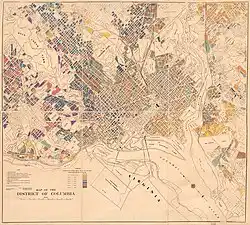
The District of Columbia has long served as a nexus of cultural and demographic transformation, shaped by multiple waves of migration throughout its history. From the movement of Indigenous peoples along the Potomac and Anacostia Rivers to the influx of Europeans, enslaved Africans, and free African Americans during the colonial period, each migration period has left indelible marks on the region’s social, economic, and political fabric. Over the centuries, shifting labor demands, evolving transportation networks, wartime upheaval, and the pursuit of civil rights and economic opportunity have fueled steady population growth in the nation’s capital. These routes, spanning pre-colonial tribal movements to contemporary international immigration, underscore Washington’s enduring role as a dynamic urban center, where diverse communities converge to shape and redefine its identity.
Research your ancestors on MyHeritage
List of District of Columbia historical migration routesList of District of Columbia historical migration routes
| Time Period | Ethnic Group | Origination Location | Arrival Location | Motivating Factors |
|---|---|---|---|---|
| Pre-colonial – 17th century | Native American (e.g., Nacotchtank, Piscataway) | Surrounding regions of the Chesapeake Bay | Banks of the Anacostia River and Potomac River (present-day D.C.) | Seasonal migration for hunting, fishing, and trade |
| Late 18th century – Early 19th century | European Americans (Anglo-American, Irish, Scottish) | Northern colonies/states (e.g., Pennsylvania), British Isles | Early neighborhoods of Georgetown and Federal City (now Washington, D.C.) | Establishment of the new Federal City; jobs in government, construction, commerce |
| 1790s – 1860 | Enslaved Africans / African Americans | Southern states (especially Maryland and Virginia plantations) | Plantations and urban households in the District | Forced migration due to the slave trade; demand for labor in developing capital |
| 1830s – Civil War (1861–1865) | Free African Americans | Adjacent slave states (Maryland, Virginia) and other northern states | Urban neighborhoods in Northwest and Southwest D.C. | Search for relative freedom, employment, educational opportunities; escape from restrictive Black Codes |
| Civil War – Reconstruction (1861–1877) | Newly freed African Americans | Confederate states (Deep South regions) | Refugee camps, contraband camps, freedmen communities in D.C. | Escape from enslavement, wartime upheaval, and hopes for protection under Union control |
| Late 19th century – Early 20th century | European immigrants (Irish, German, Italian, etc.) | Europe and Northern US port cities | Working-class neighborhoods in D.C. (e.g., Capitol Hill, Shaw, Foggy Bottom) | Factory and infrastructure jobs, building railroads, expanding urban economy |
| 1910–1930 (First Great Migration) | African Americans from rural South | Southern states (e.g., Georgia, South Carolina, North Carolina) | Urban neighborhoods across D.C. (especially Shaw, U Street corridor) | Escape racial violence (Jim Crow), search for better economic opportunities, industrial jobs |
| 1940–1970 (Second Great Migration) | African Americans from the South | Southeast and Southwest states (Mississippi, Alabama, Louisiana) | Predominantly African American neighborhoods in D.C. (e.g., Anacostia) | Defense industry jobs, improved civil rights environment, post-war economic boom |
| Mid–Late 20th century | Latin American (Salvadoran, Guatemalan, etc.) | Central America and parts of South America | Mount Pleasant, Columbia Heights, Adams Morgan | Escape civil wars, political unrest, economic hardship; reunification with family |
| Late 20th century – Early 21st century | Asian immigrants (Vietnamese, Chinese, Korean, Indian,[1] Filipino) | Southeast Asia, East Asia, South Asia | Suburban enclaves around D.C. and some city neighborhoods | Educational and professional opportunities, political asylum, family reunification |
| Early 21st century – Present | Diverse international immigrants (African diaspora, Caribbean, Middle Eastern) | Varies widely (Ethiopia, Nigeria, Jamaica, Haiti, etc.) | Greater Washington Metro area (e.g., Silver Spring, Hyattsville, D.C. neighborhoods) | Economic opportunities, political stability, existing diaspora communities |
References
- ↑ About the DC South Asian Community. South Asian Americans Leading Together

